HOME >> CHINA,SPECIAL-COVERAGE
Xinjiang’s Kizil Caves showcase history of exchanges between East and West
By Liu Xin in Aksu Source:Global Times Published: 2019/6/4 19:01:24
00:00:00
/ 05:40
○ The Buddhist caves are proof of the close exchanges between the Central Plain and Xinjiang as well as other regions along the Silk Road
○ Precious wall paintings were damaged during religious conflicts and removed by foreign explorers
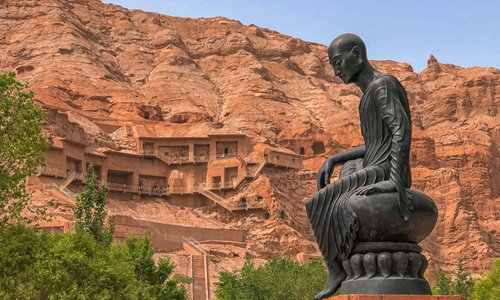
The statue of Kumarajiva in the Kizil Cave-Temple Complex in Baicheng, Aksu Prefecture of Xinjiang Uyghur Autonomous Region Photo: Liu Xin/GT
After driving east from downtown Baicheng and passing continuous stretches of desert and yardang landforms for more than an hour, a yellow cliff with several hundred caves carved into it eventually emerge. It is the Kizil Cave-Temple Complex, which was built between the 3rd and 8th centuries and is believed to be the earliest Buddhist cave complex in China.The Kizil Caves site is associated with the ancient Buddhist kingdom of Kucha [Qiuci in Chinese], located in the ancient Silk Road. The kingdom lies in present-day Baicheng county of Aksu Prefecture, Northwest China's Xinjiang Uyghur Autonomous Region.
There are 339 caves at the site with a total of 4,000 square meters of wall paintings and some colorful clay sculptures within them. All these caves were carved into the cliff of a mountain extending two kilometers from east to west.
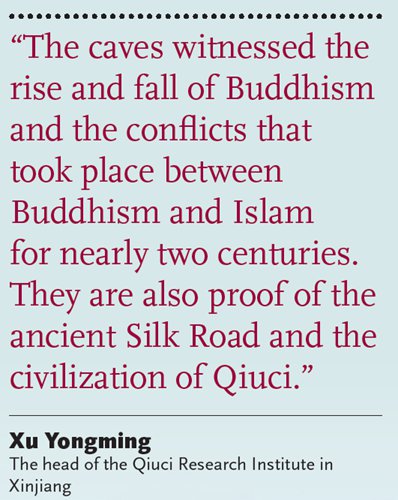
During the thousand years after their completion, the caves witnessed the rise and fall of Buddhism and the conflicts that took place between Buddhism and Islam for nearly two centuries. They are also proof of the ancient Silk Road and the civilization of Qiuci, Xu Yongming, head of the Qiuci Research Institute in Xinjiang, said at a seminar on the Kizil Caves in October 2015.
"The early caves at the site showed the history of Buddhism being introduced from India to Central Asia, the Western Regions and the Central Plain. The wall paintings inside the caves verify the exchanges between the West and the East. Paintings from Syria showed these artistic exchanges. Calligraphy works and wall paintings in the caves contain rich information and show the lifestyle and traditions of the Qiuci Kindgom," Xu said.
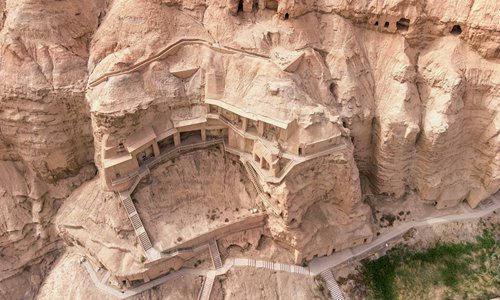
An aerial view of the Kizil Caves site Photo: Yang Ruoyu/GT
Historical proofPalida Pulati has been working at the Kizil Caves site as a tour guide for more than a year, and has seen more domestic and overseas tourists arriving in recent months. She usually starts her tours from a square at the foot of the cliff, where the statue of Kumarajiva stands.
Kumarajiva was a Buddhist monk, scholar and translator from the Kingdom of Kucha who lived from 344 to 413. He is most well known for his translation of Buddhist texts written in Sanskrit to Chinese. Through his efforts, more than 300 Buddhist classics were translated into Chinese, the first time in Chinese history that foreign classics were translated on such a large scale.
Palida said that the statue was built to commemorate Kumarajiva's contributions. After telling tourists about the life of Kumarajiva, including his experience living in Chang'an at that time, Palida then guides tourists up to the cliffs into these caves.
Many of the caves in the Kizil site have a central pillar design that allows pilgrims to walk around a central column. A large vaulted chamber is located in front of the column and a smaller rear chamber behind it, with two tunnel-like corridors on the sides linking these spaces.
Statues of Buddha were erected in the front chamber, but none of these sculptures survived at the site, Palida told the Global Times.
The wall paintings inside the caves are the most valuable cultural relics here. They not only tell stories of Buddha doing good deeds, but also of local residents' lives, animals and scenes of nature.
Unlike other Buddhist caves in China, where stories were engraved on a series of pictures, painters in the Kizil Caves usually completed a complex story on one diamond-shaped picture. For example, a picture in Cave No. 17 shows the image of a camel, two men with hats and a man with his arms up.
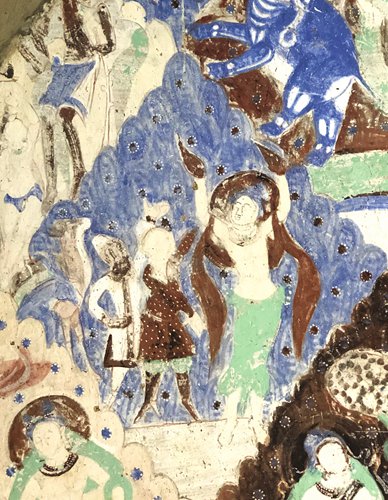
A wall painting inside the Kizil Caves site Photo: Liu Xin/GT
Palida explained that this wall painting tells the story of 500 merchants who became accidentally trapped in a dark valley. After growing increasingly anxious about being robbed in the dark, the head of the merchants wrapped his two arms in felt, dipped them in oil and lit them. He raised his arms high to guide the group in the darkness. After seven days and nights of walking, the group finally got out of the valley."If you look closely at these figures' clothes, you can see that they are wearing white hats and robes with turned-down collars. These are clothes worn by Sogdians, who usually lived in West Asia and played an important part in the trade route of the Silk Road," Palida said.
Some of the pictures include images of the gods of the Sun and Moon from Greek mythology.
"These elements show the close exchanges between the Central Plain and countries along the Silk Road," Palida told the Global Times.
More evidence of the busy cultural exchanges come from the materials used to make these wall paintings.
The wall paintings inside the caves usually have four colors - white, black, green and blue. The blue color was made from lasurite, a mineral which was produced in Afghanistan. This was also used for many cultural relics in Egypt and Europe, according to Palida.
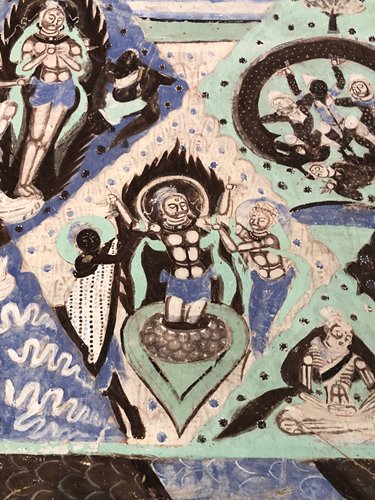
A wall painting inside the Kizil Caves site Photo: Liu Xin/GT
Great lossesWhile these wall paintings recorded scenes of prosperity along the Silk Road, they also suffered from clashes between different religions and damage by foreign explorers.
Many faces of the figures on the wall paintings were destroyed by Muslim residents and some caves were blackened from the smoke of fires built by herdsmen who rested there, Palida said.
According to Xu, Islam reached the Pamirs in around the 10th century, which triggered a clash between Buddhism and Islam that lasted nearly 200 years.
According to an introduction in the Aksu Museum on the evolution of religion in Xinjiang, in the middle of the 10th century, after Islam was accepted by the Qara Khanids dynasty, the rulers launched a religious war lasting more than 40 years to force the people to convert to Islam.
"By the middle of the 14th century, people in Kucha, Shaya, Wensu and other places were forced to believe in Islam by means such as war. By the early 16th century, Xinjiang had formed a pattern in which many religions, mainly Islam, coexisted and continued until now," Niger Tusun, from the Aksu Museum, told the Global Times.
However, not all the Buddhist elements from the caves have disappeared.
Images of honeysuckle, which were widely used in Buddhist ornaments, were found in some caves. "These flower images have been printed on the hats of the Uyghur and Kazak ethnic groups," Palida said.
More wall paintings in the Kizil Caves were removed by foreign explorers, including Sir Marc Aurel Stein, a Hungarian-born British archaeologist, and Albert Von Le Coq from Germany.
In 1906, the German expedition team of Albert Von Le Coq explored the Kizil Caves in Xinjiang and removed about 500 square meters of murals. Most of the fragments removed are now at the Museum of Asian Art in Berlin. Some fragments have been found in museums in Russia, Japan, Korea and US, according to Palida.
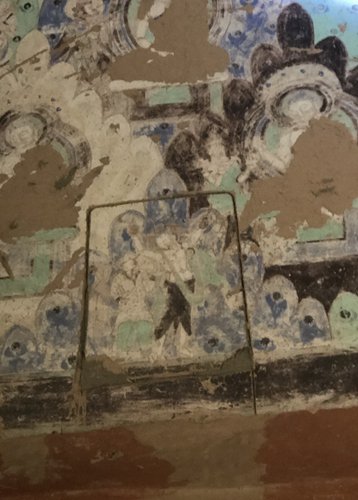
A wall painting inside a cave that was half cut out but not removed by foreign explorers. Photo: Liu Xin/GT
Under protectionPalida usually takes tour groups to Cave No. 10, which does not have any wall paintings or sculptures inside, only some words engraved by Han Leran, a Chinese artist born in 1898.
Han wrote on the wall, "I read about books of Von Le Coq and Sir Aurel Stein on their archaeological expedition in the Western Regions and began to learn that there were rich cultural relics here… it's a pity that most of the wall paintings were damaged by these teams, which was a great loss."
Palida said that Han died in a plane crash travelling from Urumqi to Lanzhou in 1947, and many first-hand materials he collected on the Kizil Caves were destroyed in the accident.
The Kizil Caves site did not have any protection until the founding of the People's Republic of China in 1949. More professional protection work of the Kizil Cave-Temple started in 1961 when it was listed in the first batch of State Protected Historical Sites. In June 2014, it was included in the World Heritage list.
Equipment to monitor humidity and air quality, as well as cameras have been installed in every cave to carry out preservation work.
Tourists are divided into small groups of no more than 10 people, and take turns to enter the caves, which have been opened to the public. They are prohibited from bringing recording equipment or using flash.
In order to allow more tourists to admire the beauty of the caves without causing damage to them, advanced technology has been used to duplicate some of the caves.
Replicas of Cave No. 17 and No. 38 have been exhibited in Aksu Museum, where tourists can see these colorful wall paintings up close and take pictures of them.
The value of the cave site has also been recognized by a growing number of scholars and visitors.
According to data from the publicity department of Aksu Prefecture, the cave site has received nearly 1 million tourists since 1992. And in the last three years, the number of tourists reached more than 200,000, with more than 10,000 of them coming from overseas.
Baicheng county plans to turn the Kizil Cave site into a national scenic spot in 2020, and make it a highlight for local tourism development.

Newspaper headline: Trove of treasures
Posted in: IN-DEPTH,FEARTURED STORIES